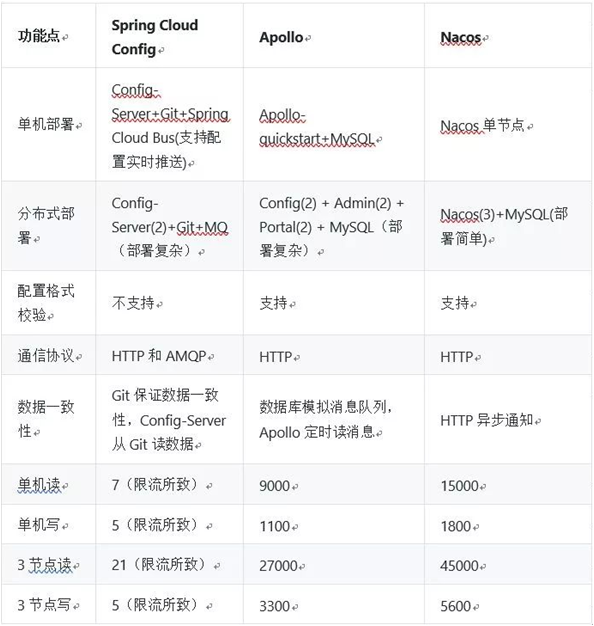nacos作为配置中心兼容xml配置文件
最近公司想要用配置中心,因为公司用的有传统的spring项目,有springboot项目,为了兼容都能够采用配置中心,做了一些尝试,经过比较还是倾向于使用nacos,传统dubbo采用spring方式读取xml读取配置文件的方式启动,其配置数据源,redis,rabbitmq等采用的是xml的配置,xml中取值是个问题,为了兼容xml能从远程配置中心更好的取值,做了一系列尝试。
比较当前的一些配置中心


Nacos的部署结构比较简单,运维成本较低。Apollo部署组件较多,运维成本比Nacos高。Spring Cloud Config生产高可用的成本最高。
Apollo支持Spring Boot和Spring Cloud项目,但是实现方式不同于标准,无法做无缝迁移,从Spring Cloud迁移到Apollo,存在代码改造和兼容性成本。
Nacos通过Spring Cloud for Alibaba支持Spring Boot和Spring Cloud生态,符合Spring生态中的标准实现方式,可以无缝从Spring Cloud Conig迁移到Nacos。
Apollo和Nacos相对于Spring Cloud Config的生态支持更广,在配置管理流程上做的更好。
Apollo相对于Nacos在配置管理做的更加全面,但使用起来也要麻烦一些。
Nacos使用起来相对比较简洁,在对性能要求比较高的大规模场景更适合。此外,Nacos除了提供配置中心的功能,还提供了动态服务发现、服务共享与管理的功能,降低了服务化改造过程中的难度。Nacos目前项目上的人力投入、社区的活跃度等也比较高
整体上来看,Nacos的读写性能最高,Apollo次之,Spring Cloud Config的依赖Git场景不适合开放的大规模自动化运维API
一、传统的spring加载xml项目启动兼容
典型启动方式是:
public static void main(String[] args) throws IOException {
ClassPathXmlApplicationContext context = new ClassPathXmlApplicationContext(
new String[] {"applicationContext.xml"});
context.start();
System.out.println("------------");
System.in.read(); // 为保证服务一直开着, 利用输入流的阻塞来模拟.
}
这种项目不适合通过注解进行,所以只能采用配置,网上参考的有些坑,主要是jar包冲突的问题,这里放上我修改的jar依赖
<dependency>
<groupId>com.alibaba.nacos</groupId>
<artifactId>nacos-spring-context</artifactId>
<version>0.3.0</version>
<exclusions>
<exclusion>
<groupId>org.springframework</groupId>
<artifactId>spring-context</artifactId>
</exclusion>
</exclusions>
</dependency>
application-nacos.xml
<?xml version="1.0" encoding="UTF-8" ?>
<beans xmlns="http://www.springframework.org/schema/beans" xmlns:nacos="http://nacos.io/schema/nacos"
xmlns:xsi="http://www.w3.org/2001/XMLSchema-instance"
xsi:schemaLocation="http://nacos.io/schema/nacos http://nacos.io/schema/nacos.xsd
http://www.springframework.org/schema/beans http://www.springframework.org/schema/beans/spring-beans.xsd"> <!--nacos配置,这里是使用配置文件的方式,这只是其中的一种方式-->
<!--开启注解-->
<nacos:annotation-driven></nacos:annotation-driven>
<!--指定nacos配置地址-->
<nacos:global-properties server-addr="localhost:8848"/>
<!--指定dataId,group-id, 是否是自动刷新-->
<nacos:property-source data-id="dubbo-config" group-id="DEFAULT_GROUP" auto-refreshed="true"/>
</beans>
同时需要将该xml导入到基本的application.xml中
<import resource="spring/applicationContext-nacos.xml" />
nacos配置中心上添加的配置内容需要什么配置什么即可。
采用注解形式
<?xml version="1.0" encoding="UTF-8" ?>
<beans xmlns="http://www.springframework.org/schema/beans" xmlns:nacos="http://nacos.io/schema/nacos"
xmlns:xsi="http://www.w3.org/2001/XMLSchema-instance"
xsi:schemaLocation="http://nacos.io/schema/nacos http://nacos.io/schema/nacos.xsd
http://www.springframework.org/schema/beans http://www.springframework.org/schema/beans/spring-beans.xsd"> <!--开启注解-->
<nacos:annotation-driven></nacos:annotation-driven> </beans>
@Configuration
@EnableNacosConfig(globalProperties = @NacosProperties(serverAddr = "127.0.0.1:8848"))
@NacosPropertySource(dataId = "dubbo-config", autoRefreshed = true)
public class nacosConfig { }
3、或者在application.xml里面整合好nacos的xml内容(命名空间,开启注解)采用注解
xmlns:nacos="http://nacos.io/schema/nacos"
xsi:schemaLocation="http://nacos.io/schema/nacos http://nacos.io/schema/nacos.xsd
同时需要注意
<nacos:annotation-driven></nacos:annotation-driven>放置的前后位置,不合适会报错,多更换几个位置试试就可以了,xml的加载顺序是从上到下来加载的
二、springboot项目兼容xml,这里有三种方式,可以采用上面的方式,也可以采用官方文档的注解方式,但是发现采用上面的方式配置动态刷新没有成功,而采用注解方式,需要注意的是注入值应该采用@NacosValue(value ="${xxxx}",autoRefreshed = true)方能能够实现自动刷新,而采用@Value("${xxxx}")不能实现自动刷新
第一种,采用同上面的方式
第二种,采用注解方式,jar包采用传统spring整合的jar包,依赖同上,
package com.topband.beings.config; import com.alibaba.nacos.api.annotation.NacosProperties;
import com.alibaba.nacos.spring.context.annotation.config.EnableNacosConfig;
import com.alibaba.nacos.spring.context.annotation.config.NacosPropertySource;
import org.springframework.context.annotation.Configuration;
import org.springframework.context.annotation.ImportResource; @Configuration
//@ImportResource({ "classpath:config/applicationContext-nacos.xml" })注:这个是采用xml配置需要添加的,因为不是采用显示加载application.xml启动
@EnableNacosConfig(globalProperties = @NacosProperties(serverAddr = "127.0.0.1:8848"))
@NacosPropertySource(dataId = "being-springboot-config", autoRefreshed = true)
public class NacosConfig { }
然后在controller注入值时采用是注入值应该采用@NacosValue(value ="${xxxx}",autoRefreshed = true)即可实现实时刷新,并且访问数据库什么的都是正常的
第三种,采用如下jar包,然后完全按照官方文档来即可
<dependency>
<groupId>com.alibaba.boot</groupId>
<artifactId>nacos-config-spring-boot-starter</artifactId>
<version>0.2.1</version>
<exclusions>
<exclusion>
<groupId>org.springframework</groupId>
<artifactId>spring-context</artifactId>
</exclusion>
</exclusions>
</dependency>
application.properties
nacos.config.server-addr=127.0.0.1:8848
启动类上加注解
@SpringBootApplication
@NacosPropertySource(dataId = "xxxx你nacos上的dataId", autoRefreshed = true)
public class NacosConfigApplication { public static void main(String[] args) {
SpringApplication.run(NacosConfigApplication.class, args);
}
}
同样的,采用@NacosValue(value ="${xxxx}",autoRefreshed = true)方能能够实现自动刷新,而采用@Value("${xxxx}")不能实现自动刷新,并且@NacosValue(value ="${xxxx}")也不能实时刷新,autoRefreshed默认为false
三、springboot直接采用springcloud的jar配置
<dependency>
<groupId>org.springframework.cloud</groupId>
<artifactId>spring-cloud-starter-alibaba-nacos-config</artifactId>
<version>0.2.1.RELEASE</version>
</dependency>
采用上述jar包去兼容xml的取值时,报不能加载属性值错误。没有成功,后来发现是application-name写错了,修改过来后,直接可用兼容。
四、一个springboot集成springcloud jar无xml配置的demo
直接采用完全注解的方式加载,写了一个小demo,采用三中依赖,不用排除上面exclusions中的包,一个独立的demo,集成redis集群,运行ok
1、bootstrap.properties
server.port=8002
spring.application.name=xxx-test
spring.profiles.active=local
spring.cloud.nacos.config.file-extension=properties
spring.cloud.nacos.config.server-addr=127.0.0.1:8848
#spring.cloud.nacos.config.namespace=d6775f80-ed7a-409a-8dbc-49b2cddee4d1
在 Nacos Spring Cloud 中,dataId 的完整格式如下:
${prefix}-${spring.profile.active}.${file-extension}
prefix默认为spring.application.name的值,也可以通过配置项spring.cloud.nacos.config.prefix来配置。spring.profile.active即为当前环境对应的 profile,详情可以参考 Spring Boot文档。 注意:当spring.profile.active为空时,对应的连接符-也将不存在,dataId 的拼接格式变成${prefix}.${file-extension}file-exetension为配置内容的数据格式,可以通过配置项spring.cloud.nacos.config.file-extension来配置。目前只支持properties和yaml类型。
通过 Spring Cloud 原生注解 @RefreshScope 实现配置自动更新:
@RestController
@RefreshScope
public class TestController {
private Logger logger = LoggerFactory.getLogger(this.getClass());
@Autowired
RedisTemplate<String,String> template;
@Value("${id}")
private String id;
@GetMapping("/getId")
public String getId(){
logger.info("看一看id的变化: {}",id);
template.opsForValue().set("hello","world");
String result = template.opsForValue().get("hello");
return "redis result: "+result+"\tid: "+id;
}
}
Redis属性及配置
package com.xx.test.config; import org.springframework.beans.factory.annotation.Value;
import org.springframework.cloud.context.config.annotation.RefreshScope;
import org.springframework.stereotype.Component; @Component
@RefreshScope
public class RedisProperties {
@Value("${redis.expireSeconds}")
private int expireSeconds;
@Value("${redis.clusterNodes}")
private String clusterNodes;
@Value("${redis.commandTimeout}")
private int commandTimeout;
@Value("${redis.maxTotal}")
private int maxTotal;
@Value("${redis.maxTotal}")
private int maxIdle;
@Value("${redis.maxWaitMillis}")
private int maxWaitMillis;
@Value("${redis.testOnBorrow}")
private boolean testOnBorrow;
@Value("${redis.maxRedirects}")
private int maxRedirects; public int getExpireSeconds() {
return expireSeconds;
} public void setExpireSeconds(int expireSeconds) {
this.expireSeconds = expireSeconds;
} public String getClusterNodes() {
return clusterNodes;
} public void setClusterNodes(String clusterNodes) {
this.clusterNodes = clusterNodes;
} public int getCommandTimeout() {
return commandTimeout;
} public void setCommandTimeout(int commandTimeout) {
this.commandTimeout = commandTimeout;
} public int getMaxTotal() {
return maxTotal;
} public void setMaxTotal(int maxTotal) {
this.maxTotal = maxTotal;
} public int getMaxIdle() {
return maxIdle;
} public void setMaxIdle(int maxIdle) {
this.maxIdle = maxIdle;
} public int getMaxWaitMillis() {
return maxWaitMillis;
} public void setMaxWaitMillis(int maxWaitMillis) {
this.maxWaitMillis = maxWaitMillis;
} public boolean isTestOnBorrow() {
return testOnBorrow;
} public void setTestOnBorrow(boolean testOnBorrow) {
this.testOnBorrow = testOnBorrow;
} public int getMaxRedirects() {
return maxRedirects;
} public void setMaxRedirects(int maxRedirects) {
this.maxRedirects = maxRedirects;
}
}
config
package com.xxx.test.config; import com.xxx.test.common.redis.JRedisClient;
import org.springframework.beans.factory.annotation.Autowired;
import org.springframework.context.annotation.Bean;
import org.springframework.context.annotation.Configuration;
import org.springframework.data.redis.connection.RedisClusterConfiguration;
import org.springframework.data.redis.connection.RedisNode;
import org.springframework.data.redis.connection.jedis.JedisConnectionFactory;
import org.springframework.data.redis.core.RedisTemplate;
import org.springframework.data.redis.serializer.StringRedisSerializer;
import redis.clients.jedis.JedisPoolConfig; import java.util.ArrayList;
import java.util.List; @Configuration
public class RedisConfig { @Autowired
private RedisProperties redisProperties; @Bean
public RedisClusterConfiguration redisClusterConfiguration(){
RedisClusterConfiguration redisClusterConfiguration = new RedisClusterConfiguration();
redisClusterConfiguration.setMaxRedirects(redisProperties.getMaxRedirects()); List<RedisNode> nodeList = new ArrayList<>(); String[] cNodes = redisProperties.getClusterNodes().split(",");
//分割出集群节点
for(String node : cNodes) {
String[] hp = node.split(":");
System.out.println("addr: "+hp[0]+"\t ip:"+Integer.parseInt(hp[1]));
nodeList.add(new RedisNode(hp[0], Integer.parseInt(hp[1])));
}
redisClusterConfiguration.setClusterNodes(nodeList);
return redisClusterConfiguration;
} @Bean
public JedisPoolConfig jedisPoolConfig(){
JedisPoolConfig jedisPoolConfig = new JedisPoolConfig();
jedisPoolConfig.setMaxIdle(redisProperties.getMaxIdle());
jedisPoolConfig.setTestOnBorrow(redisProperties.isTestOnBorrow());
jedisPoolConfig.setMaxTotal(redisProperties.getMaxTotal());
jedisPoolConfig.setMaxWaitMillis(redisProperties.getMaxWaitMillis());
return jedisPoolConfig;
}
@Bean
public JedisConnectionFactory getConnectionFactory(){
return new JedisConnectionFactory(redisClusterConfiguration(),jedisPoolConfig());
}
@Bean
public StringRedisSerializer stringRedisSerializer(){
return new StringRedisSerializer();
}
@Bean
public RedisTemplate redisTemplate(){
RedisTemplate redisTemplate = new RedisTemplate();
redisTemplate.setConnectionFactory(getConnectionFactory());
redisTemplate.setKeySerializer(stringRedisSerializer());
redisTemplate.setHashKeySerializer(stringRedisSerializer());
return redisTemplate;
}
@Bean
public JRedisClient jRedisClient(){
JRedisClient jRedisClient = new JRedisClient();
jRedisClient.setRedisTemplate(redisTemplate());
return jRedisClient;
} @Bean
public RedisTemplate redisTemplate2(){
RedisTemplate redisTemplate = new RedisTemplate();
redisTemplate.setConnectionFactory(getConnectionFactory());
redisTemplate.setKeySerializer(stringRedisSerializer());
redisTemplate.setHashKeySerializer(stringRedisSerializer());
redisTemplate.setValueSerializer(stringRedisSerializer());
return redisTemplate;
}
@Bean
public JRedisClient jRedisClient2(){
JRedisClient jRedisClient = new JRedisClient();
jRedisClient.setRedisTemplate(redisTemplate2());
return jRedisClient;
} }
nacos上配置按照约定的dataid进行配置即可。
参考:官方文档https://nacos.io/zh-cn/docs/quick-start.html
https://blog.csdn.net/qq_25484147/article/details/86358209
@SpringBootApplication @NacosPropertySource(dataId = "example", autoRefreshed = true) public class NacosConfigApplication { public static void main(String[] args) { SpringApplication.run(NacosConfigApplication.class, args); } }
nacos作为配置中心兼容xml配置文件的更多相关文章
- Nacos(四):SpringCloud项目中接入Nacos作为配置中心
前言 通过前两篇文章: Nacos(二):Nacos与OpenFeign的对接使用 Nacos(三):SpringCloud项目中接入Nacos作为注册中心 相信大家已经对Nacos作为注册中心的基本 ...
- Nacos系列:基于Nacos的配置中心
前言 在看正文之前,我想请你回顾一下自己待过的公司都是怎么管理配置的,我想应该会有以下几种方式: 1.硬编码 没有什么配置不配置的,直接写在代码里面,比如使用常量类 优势:对开发友好,开发清楚地知道代 ...
- java架构之路-(微服务专题)feign的基本使用和nacos的配置中心
上次回归: 上次我们说了ribbon的基本使用,包括里面的内部算法,算法的细粒度配置,还有我们自己如何实现我们自己的算法,主要还是一些基本使用的知识,还不会使用ribbon的小伙伴可以回去看一下上一篇 ...
- nacos作为配置中心动态刷新@RefreshScope添加后取值为null的一个问题
之前springboot项目常量类如下形式: @Component @RefreshScope//nacos配置中心时添加上 public class Constants { @Value(" ...
- Nacos作为配置中心时,多个服务共用一个dataId的配置
写在前面 本文是对我之前一篇文章<Spring Cloud+nacos+Feign,实现注册中心及配置中心>的补充.此文章中简单写了如何将Nacos作为配置中心.在使用配置中心时,我们会遇 ...
- 程序员你是如何使用Nacos作为配置中心的?
假如你使用的是spring-cloud-alibaba微服务技术栈 单个服务独有配置文件 即去除应用程序的状态,配置统一外部化管理,方便进行水平的伸缩. 集成步骤: 假如我有一个应用app-desig ...
- 使用nacos作为配置中心统一管理配置
基础环境 引入所需依赖包 <dependency> <groupId>com.alibaba.cloud</groupId> <artifactId>s ...
- SpringBoot项目使用Nacos作为配置中心
前置条件:jdk.SpringBoot项目.Nacos.Linux服务器(可无) 具体版本:jdk11.SpringBoot 2.3.5.RELEASE.Nacos 2.0.3.Centos 6 目标 ...
- Spring Cloud Alibaba基础教程:使用Nacos作为配置中心
通过本教程的前两篇: <Spring Cloud Alibaba基础教程:使用Nacos实现服务注册与发现> <Spring Cloud Alibaba基础教程:支持的几种服务消费方 ...
随机推荐
- springboot集成实现秒杀
springboot集成开发实现商场秒杀 加入主要依赖 <dependency> <groupId>org.springframework.boot</groupId&g ...
- Django框架之ORM的相关操作(一)
一.一般操作 from django.db import models import datetime # Create your models here. class Author(models.M ...
- 使用php-vmstat遇到的麻烦
workerman-vmstat是一个基于workerman的扩展,用于监听服务器应用对内存.cpu消耗的友好的查看功能,具体介绍可以去git上看: https://github.com/wal ...
- 原生js按回车键实现登录
这篇文章主要介绍了原生JS按回车键实现登录的方法,众所周知,这是在web程序设计中的一个非常实用的小技巧,主要用于表单提交,包括注册.登录等等功能,具有很好的用户体验,有着非常广泛的实用价值,需要的朋 ...
- Go语言基础之runtime包
文章引用自 Golang中runtime的使用 runtime调度器是非常有用的东西,关于runtime包几个方法: Gosched:让当前线程让出cpu以让其他线程运行,它不会挂起当前线程,因此当前 ...
- BZOJ - 1257 余数之和(数学)
题目链接:余数之和 题意:给定正整数$n$和$k$,计算$k\%1+k\%2+\dots+k\%n$的值 思路:因为$k\%i=k-\left \lfloor \frac{k}{i} \right \ ...
- cnpm - 解决 " cnpm : 无法加载文件 C:\Users\93457\AppData\Roaming\npm\cnpm.ps1,因为在此系统上禁止运行脚本。有关详细信息 。。。 "
1.在win10 系统中搜索框 输入 Windos PowerShell选择 管理员身份运行 2,打开了powershell命令行之后,输入 set-ExecutionPolicy RemoteSig ...
- 4_1 古老的密码(UVa1339)<排序>
古罗马帝国与各部门有一个强有力的政府系统,包括一个秘密服务部门.重要的文件以加密的形式发送防止窃听.在那个时代最流行的密码被称为替代密码和置换密码.例如,应用替代密码,改变所有字母“A”到“Y”字母表 ...
- c#本地缓存当数据库表更改时,缓存失效。
web.config <?xml version="1.0" encoding="utf-8"?> <!-- 有关如何配置 ASP.NET 应 ...
- 《如何写好商业计划书》---创业学习---训练营第三课---HHR---
一,<开始上课> 1,投资人不愿意约见的原因:创始人没有把项目的投资价值和亮点呈现在商业计划书里. 2,BP的三个常见的错误:不够完整,关键内容没有呈现出来:华而不实:篇幅过长. 3,预热 ...
